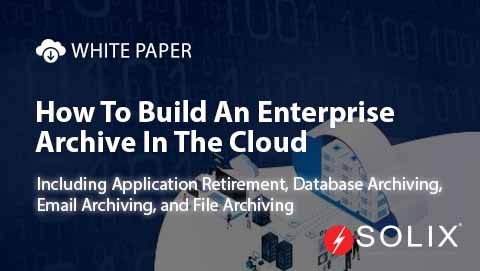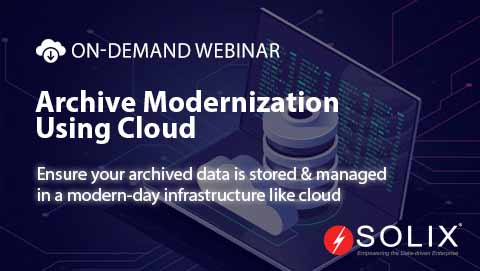as400 disaster recovery plan
Have you ever wondered what an AS400 disaster recovery plan entails and how it can help you maintain business continuity during unexpected disruptions Its a crucial aspect that every organization using IBM iSeries (AS400) systems should have in place. This blog will explore the components of an AS400 disaster recovery plan and how partnering with innovative solutions like those offered by Solix can enhance your organizations resilience.
Its fair to say that maintaining the integrity and availability of your data is crucial in todays fast-paced world. Companies across various sectors rely heavily on AS400 systems to manage their operational backbone. To illustrate this need, lets look at a real-world scenario where a robust AS400 disaster recovery plan proved indispensable.
Imagine being the IT manager at an organization that processes sensitive healthcare data. You rely on your AS400 systems for day-to-day operations. One day, a power outage causes your AS400 database to crash. Without a solid recovery plan, your organization could experience significant downtime, risking compliance with regulatory standards and loss of critical data. However, when you have an AS400 disaster recovery plan, developed in partnership with technology leaders like Solix, youre prepared to face these challenges head-on.
Lets take a deeper look at how an AS400 disaster recovery plan comes into play. For instance, a colleague of mine, James, who oversees IT operations at a healthcare facility, implemented a disaster recovery plan that utilized data management solutions to secure their AS400 systems. When faced with potential risks like hardware failures or cyberattacks, Jamess proactive approach ensured that critical data remained safe, and recovery processes ran smoothly.
The first step James took was conducting a comprehensive risk assessment. Knowing his organizations vulnerabilities allowed him to prioritize essential systems and identify areas requiring immediate attention. Solix data lifecycle management solutions played a vital role during this phase, allowing for the efficient categorization of data based on its importance to operations. This ensured that, in the event of a failure, crucial data was easy to access and restore.
After assessing risks, James developed a detailed strategy encapsulated within his AS400 disaster recovery plan. This strategic approach involved defining recovery time objectives (RTO) and recovery point objectives (RPO). The team also outlined specific protocols for data backup, failover procedures, and communication plans for internal and external stakeholders. By using Solix database archiving solutions, Jamess organization managed to automate backup processes, reducing human error and streamlining recovery timelines.
As Jamess plan unfolded, he faced a significant challenge ensuring that all employees understood their roles in the event of a disaster. To combat this, he organized training sessions, creating a culture of preparedness throughout the organization. Additionally, regular testing and updates to the AS400 disaster recovery plan became standard procedure. As technology evolves, so do threats; thus, keeping the recovery plan current was essential.
Ultimately, the real proof of Jamess investment came when a minor security breach occurred. Thanks to his well-thought-out AS400 disaster recovery plan, his team efficiently restored the systems without losing any significant data or facing prolonged downtime. The partnership with Solix provided them the agility needed to navigate through this challenge swiftly. They were back to operations within hours, a scenario that could have easily led to days of downtime without a solid plan.
Now you might be curious about the specifics of this optimization in practice. Recent research from a leading university indicates that organizations with structured disaster recovery plans report significant improvements in data retrieval times, operational efficiencies, and compliance with regulations. This research further underscores the necessity of having an AS400 disaster recovery plan in place, tailored to industry needs, just like what James experienced.
So, what does this mean for your organization If you are looking to enhance your resilience against disruptions, its time to take a proactive approach. Exploring tailored solutions from Solix could significantly improve your AS400 disaster recovery plan. Their expertise in application lifecycle management and data governance can offer you the support you need in a crisis.
Ready to level up your disaster recovery strategy Dont wait for an incident to highlight the gaps in your plan. Contact Solix today at 1-888-GO-SOLIX (1-888-467-6549) or visit their contact page for a personalized consultation. And heres an exciting opportunityby reaching out, youll also enter for a chance to win a $100 gift card! With the right tools, your AS400 disaster recovery plan can be not only effective but also a pivotal part of your organizational strategy.
As my journey as a governance and risk management leader unfolds, I find myself increasingly navigating the intricacies of AS400 disaster recovery plans, like James and his resilient team. Its a rewarding experience to witness organizations rise to the occasion, turning potential vulnerabilities into opportunities for growth and efficiency. With over 20 years of experience in this domain, Im passionate about helping others find their footing amidst data challenges.
Remember, a well-structured AS400 disaster recovery plan isnt just an insurance policyits a foundation for resilience and adaptability. Give yourself peace of mind by investing in a solution that adapts to the ever-changing landscape of technology and data management.
Disclaimer This blog is based on the personal opinions of the author and does not necessarily reflect the views of Solix Solutions.




